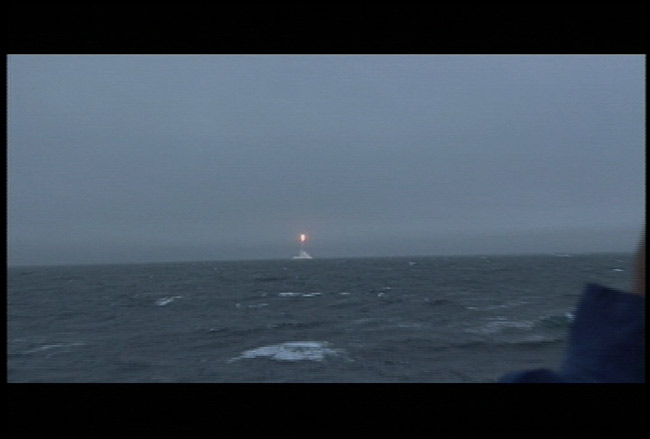Questions Cloud Launch of Cosmos 1 Solar Sail Spacecraft

This story was updated at 8:55 p.m. EDT
Despite a jubilant Tuesday launch, the flight of a privately-funded solar sail remains unclear due to a lack of telemetry from the now-silent spacecraft, mission managers said.
"This is not what we'd hoped to have happen," said Bruce Murray, co-founder of the space advocacy group Planetary Society in charge of the mission. "Negative news is not good news."
The Planetary Society's Cosmos 1 spacecraft launched skyward atop a converted Cold War-era intercontinental ballistic missile, shot skywardat about 3:46 p.m. EDT (1946 GMT) from its Russian nuclear submarine launch pad positionedbeneath the Barents Sea.
But with some apparently ambiguous telemetry, hints that their solar sail spacecraft and the potential of a launch vehicle anomaly, the actual state of Cosmos 1 is unclear.
An official statement from the Planetary Society stated that, though Cosmos 1 did launch Tuesday, flight controllers "could not confirm a successful orbit injection."
"We just don't know anything for sure,"said Emily Lakdawalla, Project Operations Assistant and Image Processing Coordinator for Cosmos 1 at The Planetary Society in Pasadena. "There's only lots of speculation."
Breaking space news, the latest updates on rocket launches, skywatching events and more!
Efforts to detect the spacecraft by U.S. Strategic Command, have apparently come up empty, mission commentators said. Mission managers are hoping that a contingency plan, which calls for several ground stations to command the orbiter to turn itself on, may make contact with Cosmos 1, but there may have been an anomaly with the spacecraft's Volna launch vehicle.
"So in sum we have some precious data and a lot of silence," said Cosmos 1 project director Louis Friedman, executivedirector of The Planetary Society, from the mission's Moscow control center. "It looks like it may be a long night here in Moscow and a long day in Pasadena."
The$4 million solar sailing project is an undertaking of The Planetary Society, apublic space advocacy group headquartered in Pasadena, California. The effortis sponsored by Cosmos Studios, a science-based entertainment company locatedin Ithaca, New York.
If successful, the Cosmos 1 solar sail will be the first to actually propel a spacecraft around Earth orbit using sunlight. The sail-carrying spacecraft was housed on the tip of the Volna rocket, which was launchedby the Russian Navy.
First signals
Reports from a tracking station on the Kamchatka Penninsula states the spacecraft was not immediately detected. A second tracking station, on the island of Majuro in the central Pacific Ocean, also did not detect Cosmos 1's signal. Mission managers said they did not expect to receive good telemetry signals from either ground station.
"This isn't necessarily unexpected," Lakdawalla said. "Petropavlovsk was a marginal contact, and it would have been happening while the spacecraft was spinning rapidly and thrusting, not an easy signal to deal with."
Some Doppler readings were initially detected, then lost. But later analysis of those signals indicated that Cosmos 1 fired its engines as programmed for an orbital insertion burn, mission managers said.
Ground observers have yet to detect direct telemetry from Cosmos 1, they added.
Cosmos 1 was expected to orbit the Earth at roughly a 500 mile (800kilometer) altitude. It was designed to gradually raise its orbit by solar sailing - usingthe pressure of light particles - photons --from the Sun upon its luminoussails.
Cosmos1 was built by the Lavochkin Association and the Space Research Institute ofthe Russian Academy of Sciences in Russia.
Anxious minutes and days ahead
Shortly beforethe rocket carrying the solar sail lifted off, Friedman anxiously awaited atLavochkin. "Everything is basically ok, and we are relaxed here. Except me...I amnot relaxed," he said.
A little oversix minutes after liftoff, Cosmos1 was expected to separate from the Volna rocket, but flight controllers have not confirmed that event.
Someten minutes into its flight, the solar sail was slated to rise into view of a portableground station situated at Petropavlovsk on Russia's Kamchatka peninsula, but other than a few Doppler signals, the probe was silent.
Thenext step called for a kick motor to start firing for some 231 seconds to inject the solar sail into Earth orbit, though again flight controllers have not confirmed orbital insertion.
Cosmos 1 mission controllers hope today's mission goes better than a previous test flight. That 2001 flight, a suborbital space shot, failed when the two-sail spacecraft was unable to eject from its Volna launch vehicle. However, there is no connection between that prior launch failure and today's mission, the state of which is still undetermined.
Visible tothe naked eye
If all hasgone according to plan, Cosmos 1 will orbit the Earth once every 101 minutes. But launch is only the beginning for the Cosmos 1 spacecraft.
PlanetarySociety spokesperson Susan Lendroth told SPACE.com that several days'worth of checks will be conducted to ensure Cosmos 1 is functioning properly.
If allchecks out, Cosmos 1 will be ready to unfurl its sails in four days.That'senough time for all the air that might have been trapped in the solar sailswhen they were packed to leak out to the vacuum of space. Cosmos 1 is designed to inflate hollow tubes along the edge of each of its eight sail blades with nitrogen gas, with four blades deploying at a time, mission managers said.
Once thesails are unfurled, the schedule calls for rotation of the sail blades,followed by use of the blades to control orientation of spacecraft.
Withsails unfurled, Cosmos 1 will be bright enough to be easily visible to thenaked eye.
To look for Cosmos 1, check out: http://www.planetary.org/solarsail/watch/

Leonard David is an award-winning space journalist who has been reporting on space activities for more than 50 years. Currently writing as Space.com's Space Insider Columnist among his other projects, Leonard has authored numerous books on space exploration, Mars missions and more, with his latest being "Moon Rush: The New Space Race" published in 2019 by National Geographic. He also wrote "Mars: Our Future on the Red Planet" released in 2016 by National Geographic. Leonard has served as a correspondent for SpaceNews, Scientific American and Aerospace America for the AIAA. He has received many awards, including the first Ordway Award for Sustained Excellence in Spaceflight History in 2015 at the AAS Wernher von Braun Memorial Symposium. You can find out Leonard's latest project at his website and on Twitter.
